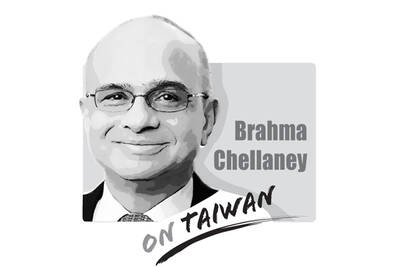A new debate on the national flag is taking place in Taiwan. The battle lines are predictable: the KMT and James Soong's (宋楚瑜) PFP are clinging to the old flag, brought over from China in 1945, while the TSU and significant parts of the DPP are in favor of a new flag that represents the new, democratic Taiwan.
It is good to take a step back and see how this issue is perceived by the international community, particularly the US and Europe. Overseas observers, governments and parliaments see Taiwan in a positive light because of its recent democratization, but the US and Europe can't bring themselves to normalize relations with Taiwan because of pressure from China.
This pressure is deep-rooted, primarily in the civil war fought from the 1920s through 1949 between the Chinese Communists and the KMT of Chiang Kai-shek (蔣介石). To the Chinese, the KMT and the ROC flag became symbols of that decades-long conflict.
Taiwan went through its democratic transformation in the 1980s and 1990s, which culminated in the election of President Chen Shui-bian (陳水扁) in March 2000. However, the new government took on the shell of the old system, including its symbols, such as the 1947 Constitution, the 1911 "made in China" flag and the equally outdated anthem -- a 1928 KMT song.
It is clear that those symbols have little to do with present-day Taiwan -- they are left-over attributes of the KMT's days in China. While it is perhaps understandable that the KMT old guard wants to cling to them out of a fast-disappearing sense of security, it would be wise for Taiwan to move to a new set of symbols.
The reasons are as follows: As long as Taiwan clings to symbols that are associated with the old civil war, it is a reminder that this civil war is not quite finished. For closure, it is necessary that these symbols are buried. An even more important reason is to find a new flag, anthem and Constitution that truly represent the new Taiwan. This process may take a few years, but it is an essential part of becoming a "new" nation. In the case of the US, it took 11 years -- from the 1776 Declaration of Independence to the 1787 Constitutional Convention. The US national anthem, The Star-Spangled Banner, wasn't written until 1814.
The old symbols represent only the KMT. Present-day Taiwan is made up of Aborigines, the Hakka- and Hokkien-speaking population, as well as the mainlanders who came over after 1945.
For Taiwan to survive, they all need to identify with the new Taiwan and evolve into a new identity that is truly Taiwanese in nature.
From the international perspective, it is also necessary to develop a new Taiwanese identity.
As long as Taiwan continues to present itself as the ROC, the international community will be forced -- by the "one China" dictum -- to maintain the line that only informal, economic and cultural ties are possible.
Only when Taiwan states clearly and unequivocally that it distances itself from the ROC identity, and presents itself as a new and democratic nation, will it be able to open the doors toward full recognition and diplomatic relations.
A fair and open debate about the national flag and anthem would be a good start.
Gerrit van der Wees and Mei-chin Chen are editors of Taiwan Communique, an international publication dedicated to democracy in Taiwan and full and equal membership of Taiwan in the international community.

As strategic tensions escalate across the vast Indo-Pacific region, Taiwan has emerged as more than a potential flashpoint. It is the fulcrum upon which the credibility of the evolving American-led strategy of integrated deterrence now rests. How the US and regional powers like Japan respond to Taiwan’s defense, and how credible the deterrent against Chinese aggression proves to be, will profoundly shape the Indo-Pacific security architecture for years to come. A successful defense of Taiwan through strengthened deterrence in the Indo-Pacific would enhance the credibility of the US-led alliance system and underpin America’s global preeminence, while a failure of integrated deterrence would
The Executive Yuan recently revised a page of its Web site on ethnic groups in Taiwan, replacing the term “Han” (漢族) with “the rest of the population.” The page, which was updated on March 24, describes the composition of Taiwan’s registered households as indigenous (2.5 percent), foreign origin (1.2 percent) and the rest of the population (96.2 percent). The change was picked up by a social media user and amplified by local media, sparking heated discussion over the weekend. The pan-blue and pro-China camp called it a politically motivated desinicization attempt to obscure the Han Chinese ethnicity of most Taiwanese.
On Wednesday last week, the Rossiyskaya Gazeta published an article by Chinese President Xi Jinping (習近平) asserting the People’s Republic of China’s (PRC) territorial claim over Taiwan effective 1945, predicated upon instruments such as the 1943 Cairo Declaration and the 1945 Potsdam Proclamation. The article further contended that this de jure and de facto status was subsequently reaffirmed by UN General Assembly Resolution 2758 of 1971. The Ministry of Foreign Affairs promptly issued a statement categorically repudiating these assertions. In addition to the reasons put forward by the ministry, I believe that China’s assertions are open to questions in international
The Legislative Yuan passed an amendment on Friday last week to add four national holidays and make Workers’ Day a national holiday for all sectors — a move referred to as “four plus one.” The Chinese Nationalist Party (KMT) and the Taiwan People’s Party (TPP), who used their combined legislative majority to push the bill through its third reading, claim the holidays were chosen based on their inherent significance and social relevance. However, in passing the amendment, they have stuck to the traditional mindset of taking a holiday just for the sake of it, failing to make good use of